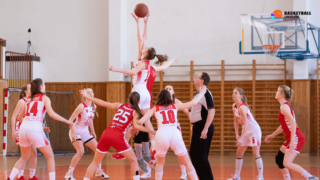
Welcome to our latest blog post, ‘What’s a High Post in Basketball?’! If you’re a hoops enthusiast with an unquenchable thirst for knowledge, you’ve come to the right place. Here, we’ll dive into the tactical world of the high post, unraveling the hows and whys behind this intriguing spot on the court. As a delightful blend of fun and professional, our discussion touches on the role of the high post, its impact on game dynamics, and even the great players who’ve excelled in this position. So, lace up those high-tops, and let’s explore the fine art of high post basketball together!
What’s a High Post in Basketball?
A high post in basketball is an offensive position located around the free-throw line, usually within the perimeter of the key. It’s an area from which the player can screen, pass, shoot, or drive to the basket. Players who excel at the high post are versatile, combining solid shooting skills with sharp decision-making and playmaking abilities. The high post is often utilized by forwards or centers to create space, challenge the defense, and open up scoring opportunities for their teammates.
The Fundamentals of the High Post in Basketball
Understanding the fundamentals of the high post begins with a look at its position on the court and the role it plays in offensive strategy. We’ll start by examining the location of the high post and why it’s so crucial to both the player and the team.
High Post Location and Purpose
In basketball, the high post is strategically located around the free-throw line, usually within the perimeter of the key or the area close to the elbows. This prime location offers a unique blend of opportunities for offensive players. When a player sets up shop at the high post, they have multiple options at their disposal:
- Execute diverse offensive moves, known as post moves
- Create space and separation from the defender
- Establish effective passing lanes to feed the ball to open teammates
- Screen and roll to the basket or pop out for a shot
Thanks to its flexible nature, the high post caters to a variety of skill sets and talents, benefiting both the individual player and the team as a whole. Establishing dominance at the high post improves offensive flow, breaks down opposing defenses, and generates high-percentage scoring opportunities.
Mastering High Post Skills and Techniques
While a powerful high post player is typically versatile and multifaceted in their skill set, certain techniques and moves are invaluable for success in this position. Let’s take a closer look at some high post abilities worth cultivating if you’re eager to excel.
Finishing at the Rim
One hallmark of a strong high post player is their ability to finish at the rim. This relies on footwork, agility, quickness, and a deft touch around the basket combined with the physical strength to finish through contact. Some players specialize in this area, boasting an array of up-and-under moves, hook shots, and drop steps to keep defenders guessing and create high-percentage scoring opportunities.
Midrange Jumper and Face-up Game
Contrary to popular belief, the high post isn’t solely about brute force and physicality; effective high post players also develop polished shooting mechanics and a lethal midrange jumper. A solid face-up game, in which the player faces the basket and keeps the defender guessing, is key. Armed with a face-up game and midrange jumper, high post players can force defenders to respect their shot, opening up even more opportunities for scoring and playmaking.
Effective Passing
A top-notch high post player can also function as a primary or secondary playmaker on the court, thanks to their well-honed passing skills. Effective passing from the high post is an absolute game-changer, as it prompts the defense to collapse on the player, which in turn opens up myriad opportunities for backdoor cuts, drive-and-kick scenarios, and wide-open three-pointers. In summary, strong high post passers not only create their own scoring chances but also facilitate opportunities for their teammates to shine.
Screening and Picking
Another crucial skill for high post players is the ability to set effective screens or picks for their teammates. Whether it’s a stationary screen or a pick-and-roll, setting up teammates for open shots or rolls to the basket is invaluable in breaking down the defense and maintaining offensive flow. Mastering the nuances of screening and rolling or popping is essential for any aspiring high post player, ensuring they become an integral part of their team’s offensive game plan.
Noteworthy High Post Players Throughout History
Throughout basketball history, some of the game’s most legendary players have made their mark on the high post, captivating fans and setting the standard for excellence in the position. Let’s pay homage to a few notable figures who’ve reigned supreme at the high post.
Basketball Legends and High Post Dominance
When it comes to basketball and high post play, several iconic players come to mind:
- Tim Duncan: The “Big Fundamental” was known for his impeccable footwork, midrange jumper, and extraordinary passing skills. Duncan’s high post expertise was a cornerstone of the San Antonio Spurs’ championship runs.
- Dirk Nowitzki: This sharpshooting 7-footer changed the game with his versatile face-up play and silky smooth fadeaway jumper. Nowitzki’s ability to stretch the floor and shoot from the high post was nearly unstoppable.
- Kevin Garnett: An athletically gifted power forward and center, Garnett made his name with aggressive play and a dynamic skill set. His tenacious defense and relentless motor were matched only by his offensive prowess at the high post.
- Alonzo Mourning: A force to be reckoned with on both ends of the floor, “Zo” Mourning was a dominant high post player during his era. With a lethal combination of powerful post moves and an extended shooting range, he left opposing defenders helpless in his wake.
These legends of the game are emblematic of what it truly means to excel at the high post, providing a blueprint for aspiring players to follow as they seek to develop their own high post mastery.
Drills for Developing High Post Proficiency
So, you’re eager to get out there and dominate the high post like the legends before you? Here are a few tried-and-true drills designed to hone your skills and elevate your high post game. Quick, focused repetitions and consistent practice will accelerate your progress and unleash your full potential.
Individual High Post Drills
To work on high post skills by yourself, consider the following drills:
- Chair Closeouts: Place a chair at the high post position, dribble towards it, execute a move or shot upon reaching the chair, and then retreat to grab the rebound. Mix up your moves and shots to simulate a variety of in-game scenarios.
- Mikan Drill: Stand underneath the basket, and practice making quick layups on one side of the rim before switching to the other side without letting the ball touch the ground. This drill refines your touch around the basket and builds confidence in your finishing abilities.-
- Elbow Shooting: Drilling your shooting from the high post, or “elbows” of the court, is an excellent way to develop and maintain confidence in your midrange jumper. Shoot from each elbow, focusing on form and rhythm while keeping track of your makes and misses to chart progress.
Partner High Post Drills
When tackling high post drills with a partner, keep these in mind:
- Two-Ball Passing: Grab a partner, each holding a basketball. Stand approximately 10 to 15 feet apart, and quickly deliver one- and two-handed passes to each other while maintaining control of your respective balls. This drill enhances your passing speed, accuracy, and overall dexterity.
- One-on-One Defense: Challenge a partner to one-on-one play, with the offensive player initiating at the high post. Switch roles frequently to ensure you’re developing both offensive and defensive skills simultaneously. This drill fosters a diverse range of high post moves while offering valuable feedback on your effectiveness in-game situations.
- Screen-and-Roll: With a partner acting as a defender or “dummy” defender, practice setting screens and then cutting to the basket (rolling) or stepping back for a shot (popping). Do this repeatedly, experimenting with different angles, passes, and shot locations to maximize the authenticity of this drill.
Whether you’re a promising prospect or a seasoned veteran, the vast world of the high post in basketball offers endless opportunities for growth and refinement. By diving into its strategic nuances and committing to focused practice, you can elevate your game and make an indelible mark on your team’s success both on and off the court.
Defensive Strategies Against the High Post
Now that we’ve comprehensively explored the realm of high post offense, let’s delve into the defensive aspect. Knowing how to neutralize the threat posed by a formidable high post player can be the key to winning crucial games. Let’s break down a few defensive strategies that can stymie even the most skilled offensive high post players.
Fronting the Post
One defensive tactic to combat high post offense is “fronting” the post. This strategy involves the defender positioning themselves in front of the offensive player, preventing an easy entry pass and effectively denying them possession. By maintaining active hands and feet, the defender can complicate matters for the opponent, forcing them into tough long-range passes or deterring them altogether. However, fronting the post can leave your team vulnerable to lobs and backdoor cuts, so it’s best to utilize this strategy with strong communication and available weak-side help.
Double-Teaming
Another option for mitigating the impact of a dominant high post player is double-teaming. This involves sending an extra defender to swarm the offensive player and force a pass, hopefully resulting in a turnover, contested shot, or other unfavorable outcomes for the offense. Timing is crucial when double-teaming, as pre-emptively leaving one’s assigned player might result in an easy assist to an open teammate. Coordinated communication and backside rotations can help in minimizing these risks.
Sagging and Denying Passing Lanes
A great way to limit the performance of an exceptional high post player is to sag off your immediate assignment and place your body between the high post and the ball handler. By denying passing lanes and clogging space in the key, defenders increase the chances of intercepting passes, forcing turnovers, and frustrating the offense. Be ready to close quickly on immediate threats and ensure held teammates can rotate to combat open shots and drives.
High Post Offense Variations
To appreciate the high post’s impact on basketball strategy, it’s worth examining a few offensive systems that leverage this potent position. Teams at various skill levels have successfully implemented these schemes, showcasing the tactical range afforded by a strong high post player.
Triangle Offense
The triangle offense, popularized by legendary NBA coach Phil Jackson, capitalizes on the prowess of its high post player. This scheme revolves around forming a triangle with a post player, a wing player, and a corner player. The high post player has multiple options in this setup: attack the basket, pass to the wing or corner, or set screens for perimeter players. The triangle offense thrives on quick player movement and crisp passes, making it a potent weapon in the hands of a skilled and knowledgeable team.
Princeton Offense
In the Princeton offense, cutting and passing are the lifeblood of the system. Known for centering on motion and fluidity, this offense often places a skilled high post player at the core. This player’s primary role is to act as the hub of ball and player movement, ensuring the offense remains in constant motion. The power of the Princeton offense lies in exploiting defensive breakdowns and capitalizing on mismatches, using screens, backdoor cuts, and quick passes to create open shots and easy baskets.
Flex Offense
The flex offense is a continuity-based offensive system that emphasizes passing, screening and cutting, with opportunities for the high post to shine. The flex offense efficiently combines elements of pick-and-roll and off-ball screens, creating space for the high post to facilitate passes and unleash potent scoring-threats. This offensive scheme excels at exhausting and breaking down defenses through constant movement, forcing defenders to fight through screens and stay focused for the entire possession.
The world of high post mastery in basketball is rich and diverse, featuring numerous strategic variations and layers of complexity. In the hands of dedicated and tactically-aware players, the high post becomes a formidable weapon of both individual prowess and collective team success. Immerse yourself in these intricate details, and watch your game flourish like never before.
Frequently Asked Questions
Ready to dig even deeper into the world of the high post in basketball? In this FAQ section, we’ve compiled 13 common questions and concise answers to help you satisfy your curiosity and develop a well-rounded understanding of this unique and captivating element of the game.
1. What is the low post in basketball?
The low post in basketball is an offensive position located close to the baseline, typically on either block situated on either side of the key. It’s primarily used by forwards and centers to score points and make plays using their size, strength, and post moves.
2. What is a power forward’s role in the high post?
A power forward’s role in the high post includes passing, shooting, driving to the basket, and setting screens. Power forwards adept at the high post use their size, strength, and versatility to challenge defenders and create scoring opportunities for their team.
3. How does a high post player differ from a low post player?
A high post player typically has a more versatile skill set, including shooting, passing, and playmaking abilities. In contrast, a low post player often relies on strength, size, and post moves to score points and dominate opponents closer to the basket.
4. Why is the high post crucial for offensive strategy?
The high post is crucial for offensive strategy because it allows for the creation of scoring opportunities through various options, such as passing, shooting, driving, and screening. High post players can challenge defenses and generate offensive flow, leading to high-percentage shots and open teammates.
5. How can I become an effective high post player?
To become an effective high post player, focus on developing skills like midrange shooting, passing, finishing at the rim, and setting screens or picks. Consistent practice, game experience, and learning from successful high post players can enhance your abilities over time.
6. What are some drills I can do to improve my high post game?
To improve your high post game, practice individual drills like chair closeouts, the Mikan Drill, and elbow shooting. Partner drills, such as two-ball passing, one-on-one defense, and screen-and-roll, can also help sharpen your high post skills and technique.
7. How can defenders neutralize a high post player’s impact on the game?
To neutralize a high post player’s impact, defenders can employ strategies such as fronting the post, double-teaming, and sagging off their assignment to deny passing lanes. Effective communication, timely rotations, and teamwork are essential to minimizing offensive opportunities.
8. Which basketball offensive systems are known for their use of the high post position?
Some notable basketball offensive systems that utilize the high post position include the triangle offense, the Princeton offense, and the flex offense. These systems highlight the importance of a skilled high post player while emphasizing motion, passing, and player involvement.
9. What physical attributes are crucial for a successful high post player?
Physical attributes crucial for a successful high post player include size, strength, agility, quickness, and good touch around the basket. These attributes, combined with a versatile skill set, are key to succeeding in the high post position.
10. Can guard positions also operate in the high post?
Yes, guard positions can also operate in the high post, especially if they possess the necessary skills, such as passing, shooting, and playmaking abilities. Versatility is critical in basketball, and guards that can perform well in the high post position can create mismatches and challenge defenders.
11. How does the high post affect spacing on the court?
The high post affects spacing on the court by creating distance between defenders and offensive players, opening up passing lanes and driving opportunities. High post players who can shoot, pass, or drive to the basket further enhance spacing by drawing defenders away from their assignments.
12. What is a “stretch four” in basketball?
A “stretch four” in basketball is a power forward who excels at shooting from beyond the arc, effectively stretching defenses with their shooting range. This player can create offensive mismatches, operate both inside and outside the perimeter, and open up the floor for teammates.
13. How has the high post evolved in modern basketball?
The high post has evolved in modern basketball with the growing emphasis on shooting, versatility, and player movement. High post players today are expected to possess a broader skill set, including shooting from three-point range and playmaking abilities, thereby increasing their impact on the game.
Featured Posts
- No pillar pages found.





